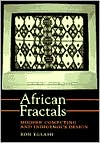African Fractals: Modern Computing and Indigenous Design
Fractals are characterized by the repetition of similar patterns at ever-diminishing scales. Fractal geometry has emerged as one of the most exciting frontiers on the border between mathematics and information technology and can be seen in many of the swirling patterns produced by computer graphics. It has become a new tool for modeling in biology, geology, and other natural sciences.\ Anthropologists have observed that the patterns produced in different cultures can be characterized by...
Search in google:
Fractals are characterized by the repetition of similar patterns at ever-diminishing scales. Fractal geometry has emerged as one of the most exciting frontiers on the border between mathematics and information technology and can be seen in many of the swirling patterns produced by computer graphics. It has become a new tool for modeling in biology, geology, and other natural sciences. Anthropologists have observed that the patterns produced in different cultures can be characterized by specific design themes. In Europe and America, we often see cities laid out in a grid pattern of straight streets and right-angle corners. In contrast, traditional African settlements tend to use fractal structure--circles of circles of circular dwellings, rectangular walls enclosing ever-smaller rectangles, and streets in which broad avenues branch down to tiny footpaths with striking geometric repetition. These indigenous fractals are not limited to architecture; their recursive patterns echo throughout many disparate African designs and knowledge systems. Drawing on interviews with African designers, artists, and scientists, Ron Eglash investigates fractals in African architecture, traditional hairstyling, textiles, sculpture, painting, carving, metalwork, religion, games, practical craft, quantitative technologies, and symbolic systems. He also examines the political and social implications of the existence of African fractal geometry. His book makes a unique contribution to the study of mathematics, African culture, anthropology, and computer simulations.
AcknowledgmentsPt. IIntroductionCh. 1Introduction to fractal geometry3Ch. 2Fractals in African settlement architecture20Ch. 3Fractals in cross-cultural comparison39Ch. 4Intention and invention in design49Pt. IIAfrican fractal mathematicsCh. 5Geometric algorithms61Ch. 6Scaling71Ch. 7Numeric systems86Ch. 8Recursion109Ch. 9Infinity147Ch. 10Complexity151Pt. IIIImplicationsCh. 11Theoretical frameworks in cultural studies of knowledge179Ch. 12The politics of African fractals192Ch. 13Fractals in the European history of mathematics203Ch. 14Futures for African fractals216AppMeasuring the fractal dimension of African settlement architecture231Notes235References243Index253








